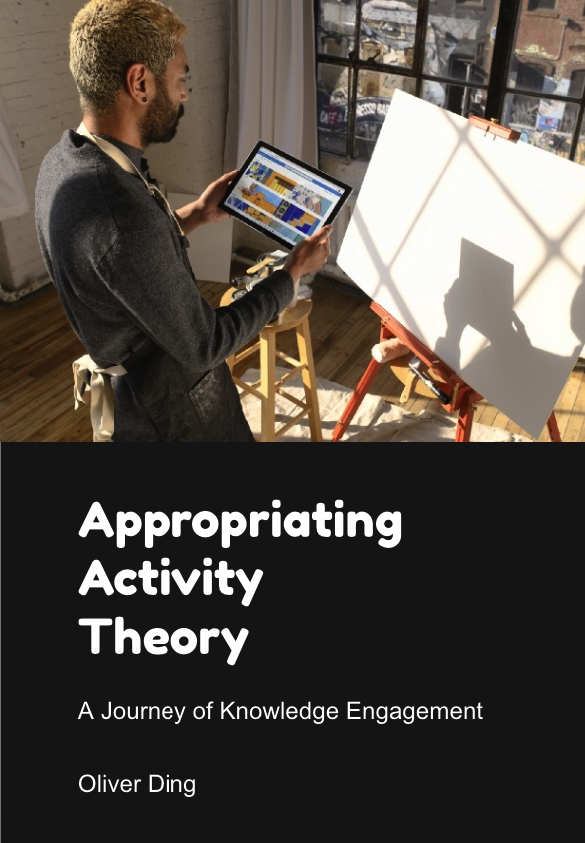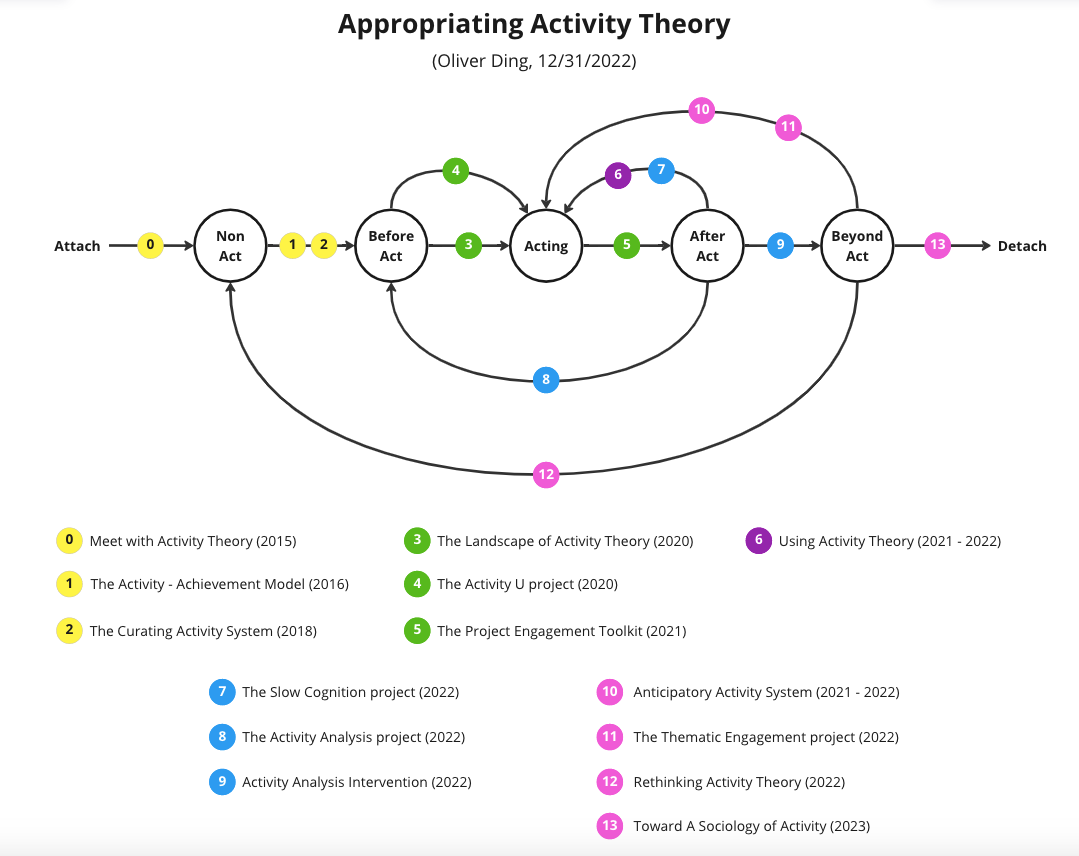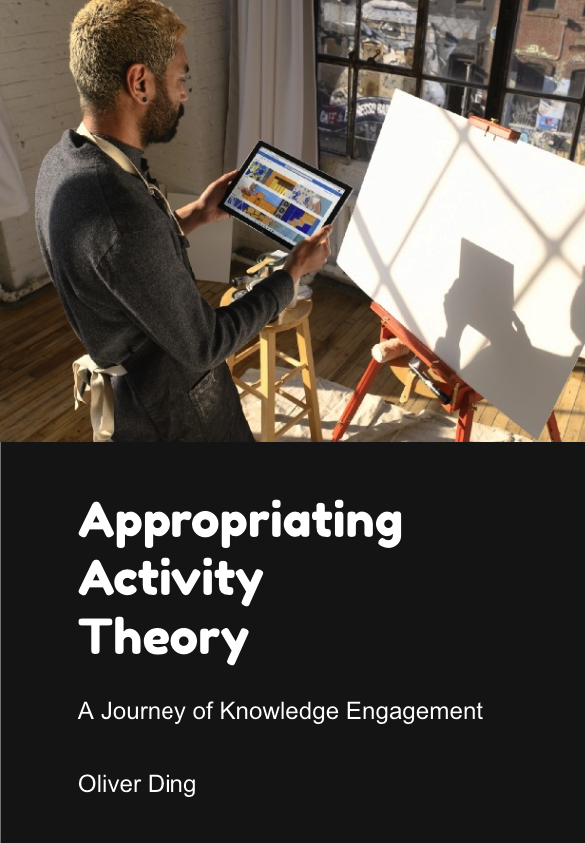Appropriating Activity Theory (Book)

A Journey of Knowledge Engagement
In the past several months, I reflected on the journey of engaging with Activity Theory from 2020 to 2022 and wrote several long articles. Each time I used a diagram or a framework to model the journey from a specific perspective.
For example, I developed Mapping Thematic Journey on Sept 15, 2022 and used it to reflect on four projects about Activity Theory.

On Oct 19, 2022, I developed the Creative Life Curation framework. I used the framework to reflect on the Activity U project on Nov 16, 2022. See the diagram below.

Initially, my purpose was to develop some methods and frameworks for the Creative Life project. Later, I realized that I can collect these articles together and curate them into a new meaningful whole.
What's the new meaningful whole?
It represents a journey of "Person-Theme" engagement. While I am the person, the theme refers to Activity Theory and related knowledge enterprise.
On Sept 9, 2022, I wrote an article titled The Attachance Framework (2018) and Thematic Engagement and introduced the Attachance framework. Today I used the framework to reflect on the "Oliver - Activity" thematic engagement. See the diagram below.

The above diagram highlights several important movements of my journey of Appropriating Activity Theory from 2015 to 2022.
How did I make this diagram?
I consider the Activity U knowledge curation project (#4) as the central point of the journey.
I started the Activity U project on August 19, 2020. Initially, I just made a diagram called “Activity U” which is a test of the “HERO U” framework. I wrote a post titled The Landscape of Activity Theory to explain the diagram “Activity U”.
This is the #3 movement.
From August 2020 to Jan 2021, I worked on the Activity U project and wrote a series of articles about Activity Theory.
This is the #4 movement.
Eventually, I edited two possible books:
Finally, I also launched a toolkit called Project Engagement in Feb 2021.
This is the #5 movement.
Before the Activity U project
From the perspective of the Attachance framework, there are some moments before the Activity U project. For example:
#0: Meet with Activity Theory (2015)
In 2015, a friend of mine recommended Activity Theory in a private discussion in a social media group. This was the starting point of my journey of Appropriating Activity Theory.
#1: The Activity - Achievement Model (2016)
As a serial creator and a lifelong thinker, I am passionate about intellectual development and life reflection. Initially, I was influenced by Chris Argyris’ Action Science and Donald Schön’s Theory in Practice and The Reflective Practitioner.
I wrote my first learning autobiography in 2015 and was attracted to biographical studies. In 2016, I developed a framework called Career Landscape which is inspired by Activity Theory, Communities of Practice, and other ideas. I also developed a series of tools such as the Learning Autobiography Guide, Learning & Reflective Cards, Learning & Reflective Canvas, Learning & Reflective Monthly Report Template, etc.
Later, I renamed it The Talent Circle: the Activity - Achievement model.
The Activity-Achievement Model (2016) is my early knowledge curation work. It was born from a 1:1 life reflection coaching project. In order to explain the client's life and career experience, I made the Activity-Achievement model for the case.
You can find more details in a short post on Linkedin.
#2: The Curating Activity System (2018)
In April 2018, I reflected on an early project BagTheWeb which is a web content curation tool. I adopted the Activity System model and the idea of “mediated artifact” from Activity Theory to develop a framework for understanding the BagTheWeb project and the Curating activity in general.
I built a model called Curating Activity System for discussing the Curating Activity in general by reflecting on my practice of BagTheWeb with theoretical resources from Activity Theory.
Though I was satisfied with the Curating Activity System model because I built an abstract knowledge framework that can be used for different products, I realized that I was wrong in understanding the Activity System model and Activity Theory in general.
If you compare the Curating Activity System diagram with the original Activity System model diagram, you will find the same visual layout. But, my conceptualization is a totally different thing. My six elements don’t correspond to the Activity System model’s six elements. Moreover, I didn’t realize that I work on developing a model for individual curating activity, and the Activity System model is for studying collective activities.
Thus, I coined the term Misdiagramming to encourage myself to remember this mistake. Though the final result of the Curating Activity System is fine, the process indicated that I didn’t precisely understand the Activity System model and Activity Theory. I was tricked by my own visual preference because the visual layout is easy to adopt while the conceptual structure is hard to learn.
You can find more details in the 7.7.3 section (Misdiagramming and Contaminated Mindware) in D as Diagramming: An Integrated Framework for Studying Knowledge Diagrams (Part 3B).
After the Activity U project
The above diagram highlights the following movements:
#6 Using Activity Theory (2021 - 2022)
#7 The Slow Cognition project (2022)
#8 The Activity Analysis project (2022)
#9 Activity Analysis Intervention (2022)
#6 Using Activity Theory (2021 - 2022) refers to a series of projects about other themes. While these projects don't consider Activity Theory as their objective, I used some ideas from Activity Theory as tools for these projects.
For example, the Knowledge Discovery project and the Life Discovery project both use the concept of "Mediating Tool" from Activity Theory. See the diagram below.

You can find more details in Mapping Thematic Journey (Engaging with Activity Theory, 2020 - 2022).
I also defined several particular types of Activity. You can find more details in Activity as Practice.
#7 The Slow Cognition project (2022) refers to Creative Work Study. I worked on both Howard E. Gruber’s approach and “Activity Theory” related approaches (especially Project-oriented Activity Theory and the “Anticipatory Activity System” framework). I realized that it’s possible to use the concept “Slow Cognition” to connect these two approaches.

You can find more details in The Slow Cognition Project and related methods.
#8 The Activity Analysis project (2022) refers to Activity Analysis Center and its website ActivityAnalysis.net. You can find more details in Activity Analysis Center: Curativity, Creativity, and Activity.
#9 Activity Analysis Intervention (2022) refers to the Activity Analysis Intervention (AAI) Program which is the first collaborative project between Activity Analysis Center and Curativity Center. You can find more details in The ARCH of Synergy Effects.
Beyond the Activity U project
The last section includes the following movements:
#10 Anticipatory Activity System (2021 - 2022)
#11 The Thematic Engagement project (2022)
#12 Rethinking Activity Theory (2022)
#13 Toward A Sociology of Activity (2023)
#10 Anticipatory Activity System (2021 - 2022) refers to the Anticipatory Activity System (AAS) framework which is inspired by Activity Theory, Anticipatory system theory, relevance theory, and other theoretical resources. I started the project on August 21, 2021 and wrote a review on August 28, 2022. You can find more details in Slow Cognition: The Development of AAS (August 21, 2021 - August 26, 2022). I also applied the AAS framework to study Life Strategy, the outcome is a possible book titled Advanced Life Strategy: Anticipatory Activity System and Life Achievements.
#11 The Thematic Engagement project (2022) refers to The Thematic Engagement Toolkit (v1.0). From June 2022 to September 2022, I developed a set of new tools for knowledge engagement, thematic controversy, etc. These tools refer to a dialogue between the following two knowledge frameworks:
- The Themes of Practice Approach (2019, 2021)
- The Project Engagement Approach (2021, 2022)
The Themes of Practice Approach (2019, 2021) is part of Curativity Theory, while the Project Engagement Approach (2021, 2022) is inspired by Activity Theory, especially Andy Blunden’s Project-oriented approach to Activity Theory.
You can find more details about the development of "Thematic Engagement" in Slow Cognition: The "Activity - Opportunity" Thematic Dialogue.
#12 Rethinking Activity Theory (2022) refers to a question: Is Activity Theory a Sociological Theory? This question was born from my journey of learning Ping-keung Lui's theoretical sociology. You can find more details in Re-learning Activity Theory.
Inspired by Ping-keung Lui's theoretical sociology, I wrote a thesis about the Project Engagement approach (v2.1) in July 2022. Part 5 of the thesis is the outcome of re-learning Activity Theory. I discovered the following pairs of keywords for discussions: Concepts and Themes, Project and Platform, Culture and History, Context and Settings, etc. Finally, I made a "meta-framework" for the Project Engagement approach (v2.0). See the picture below.

Later, I also used Ping-keung Lui's theoretical sociology and his semiotic system diagramming method to curate three theoretical approaches and four frameworks together for understanding creative life.

The outcome of the theoretical curation project is a systematic approach to Creative Life. It led to four possible books which form a series called Aspects of Creative Life.

#13 Toward A Sociology of Activity (2023) refers to a significant insight about the systematic approach to Creative Life. Some friends tell me that this new approach can answer my question: Is Activity Theory a Sociological Theory? They suggested that I can call the new approach A Sociology of Activity.
Wow! What a wonderful journey of knowledge engagement!
A New Possible Book
My journey of engaging with Activity Theory was inspired by several Activity Theorists. The starting point of the journey is located at the intersection between Activity Theory and HCI (Human-computer interaction) since my daily job is digital interaction design.
I started reading books such as Activity Theory in HCI and Acting with Technology: Activity Theory and Interaction Design. Then I noticed that there is an author behind these books: Bonnie A. Nardi.
Bonnie A. Nardi is an activity theorist, HCI researcher, and anthropologist. She is well known for her work on activity theory, interaction design, games, social media, and society and technology. She was a professor at the University of California, Irvine. She was elected to the ACM CHI Academy in 2013. You can find her story in Activity U (III): Bonnie Nardi’s Choices and Boundary Knowledge Work.
I was encouraged by her short biography Appropriating Theory.
Now I'd like to use Appropriating Activity Theory as the title of a new possible book.

Though I have edited several possible books about Activity Theory. The new possible book is unique. It aims to represent my journey of engaging with Activity Theory.
I'd like to use the following six parts to curate related articles.
- Part 1: The Journey
- Part 2: The Curation
- Part 3: The Creation
- Part 4: The Dialogue
- Part 5: The Discovery
- Part 6: The Anticipation
Part 1: The Journey
Part 1 aims to collect my reflections on the journey. During the past several months, I worked on the Slow Cognition project and used my journey of engaging with Activity Theory several times. Now it's time to collect these articles together.
- Z Lab @ Activity Analysis Center - 7 min
- Mapping Thematic Spaces #2 — The “Activity” Thematic Space - 16 min
- The Activity U Project and Creative Life Curation - 20 min
- The "Activity - Opportunity" Thematic Dialogue - 19 min
- Mapping Thematic Journey (Engaging with Activity Theory, 2020 - 2022) - 37 min
- The Development of AAS (August 21, 2021 - August 26, 2022) - 17 min
Part 2: The Curation
Part 2 collects several articles about Activity Theory. It offers readers a landscape of traditional Activity Theory. These articles were written in 2020 under the Activity U project.
- The Landscape of Activity Theory (19 min read)
- The Hierarchy of Human Activity and Social Practice (43 min read)
- The Engeström’s Triangle and the Power of Diagram (47 min read)
- The Chain of Activity and Life as Temporal Activity Chains (53 min read)
- Typology of Activities and Other Practical Tools (25 min read)
- Project as a Unit of Activity (40 min read)
- Project-oriented Activity Theory (50 min read)
Part 3: The Creation
Part 3 is about my own knowledge creations such as the “Project Engagement” approach, the “Anticipatory Activity System” framework, the “Life-as-Project” approach, the “Creative Work Study” project, the “Activity Circle” model, etc.
It also refers to my creative design activities of making instruments for some particular activities.
- Life as Activity (0.3) - 37 min
- The SET Framework - 8 min
- The Activity Circle (Oliver Ding, 2017) - 9 min
- The Talent Circle: The Activity - Achievement Model (2016)
- ARCH: A Visual Language of Interpersonal Interactions and Collaborative Project Engagement - 6 min
- D as Diagramming: An Integrated Framework for Studying Knowledge Diagrams (Part 3A) - 16 min
- D as Diagramming: An Integrated Framework for Studying Knowledge Diagrams (Part 3B) - 20 min
- The Life Discovery Canvas (v1.0) — Part 1: Theoretical Background - 15 min
- The Life Discovery Canvas (v1.0) — Part 2: Spatial Structure - 15 min
- The Slow Cognition Project and related methods - 8 min
Part 4: The Dialogue
In the past two years, I also worked on connecting Activity Theory and other theoretical approaches in order to develop new knowledge frameworks for some projects. Part 4 collects related articles.
- Lifesystem: Modeling Ice Skating and Other Social Practices - 28 min
- Strategy as Anticipatory Activity System - 16 min
- Diagram Blending: “Activity Circle” + “Concept Dynamics” - 11 min
- The Attachance Approach to Creative Journey - 10 min
- The Attachance Framework (2018) and Thematic Engagement - 8 min
- The "Activity - Opportunity" Thematic Dialogue - 19 min
- The Echoes of A Thematic Dialogue - 13 min
- The Thematic Engagement Toolkit (v1.0) - 14 min
Part 5: The Discovery
Part 5 features several important articles about the journey. They present significant insights I learned from the journey.
- Thematic Space: The Art of Continuous Discovery - 18 min
- Project-oriented Activity Theory (Book) - 16 min
- Activity U — A Knowledge Curation Project - 19 min
- Project Engagement (v2.1) as an Innovation Approach - 7 min
- Project Engagement (v2): Life, History, and Multiverse - 16 min
- Three Paths of Creative Life and A Semiotic System - 30 min
- A Semiotic System Diagram for Creative Life Curation - 12 min
- A Typology for Anticipatory Activity System - 9 min
- The World of Activity for Creative Life Curation - 14 min
Part 6: The Anticipation
Part 6 discusses the future of the journey.
- Activity Theory, Practice Theory, and Beyond
- Toward A Sociology of Activity - coming soon

